Survey:
Retaining tech employees in the era of The Great Resignation

Introduction
The quit rate in the U.S. is spiraling out of control, hitting a record high in August 2021. While roughly half of the American workforce says they intend to quit within the next 12 months.
This wave of job turnover, known as “The Great Resignation” – a term coined by Dr. Anthony Klotz of Texas A&M University – is causing a major talent and skills shortage in the job market. Fueled by the pandemic and the resulting workplace changes, this phenomenon seems to affect some professions more than others.
A new survey by TalentLMS and Workable, presented in this report, shows that a sweeping 72% of employees working in tech/IT roles are thinking of quitting their job in the next 12 months. This is significantly higher than the 55% rate of the overall U.S. workforce.
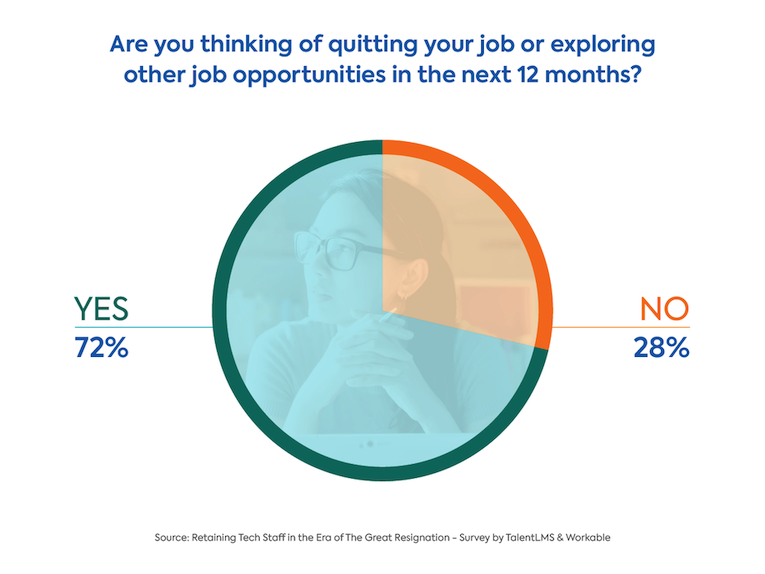
The 1,200 survey respondents are U.S. employees who work in a tech/IT/software department of their companies. We asked them what the reason was behind their desire to jump ship, how the pandemic has affected them, and what they value the most when choosing a company to work for. Finally, tech workers had an opportunity to voice their opinions about what companies should do if they want to retain them.
Key findings
-
72% of tech workers are thinking of quitting their jobs or exploring other job opportunities in the next 12 months.
-
9 in 10 would like to get more learning and development opportunities from their company.
-
Top reasons for wanting to quit a job (other than salary and benefits):
1. Limited career progression (41%)
2. Lack of flexibility in working hours (40%)
3. Having a toxic work environment (39%) -
Top criteria when selecting a company to work for:
1. Salary and benefits (76%)
2. Skills development (58%)
3. Flexibility/remote work options (56%)
-
More than half of respondents (58%) say they suffer from job burnout. And those who suffer from burnout are twice as likely to quit their job as those who don’t.
-
1 in 3 respondents says a lack of remote work options is a reason that would make them want to quit their job.
-
62% say more learning and training opportunities would make them more motivated at work.
-
75% agree that their companies focus more on attracting new employees instead of investing in the existing ones.
Why are tech employees leaving their jobs?
Tech employees seem to highly value having room for growth. When looking at the reasons why tech workers leave their jobs, 41% responded that they do so because it doesn’t offer them opportunities for career progression.
That was closely followed by flexibility in working hours. While remote and hybrid work are still dominating the public conversation, IT employees seem to value flexibility in working hours a bit more than working remotely.
Finally, for 32% of the respondents, a lack of learning and development opportunities is a reason to quit. It’s worth mentioning that a handful of respondents spontaneously mentioned “vaccine mandates” as a reason to quit their jobs.
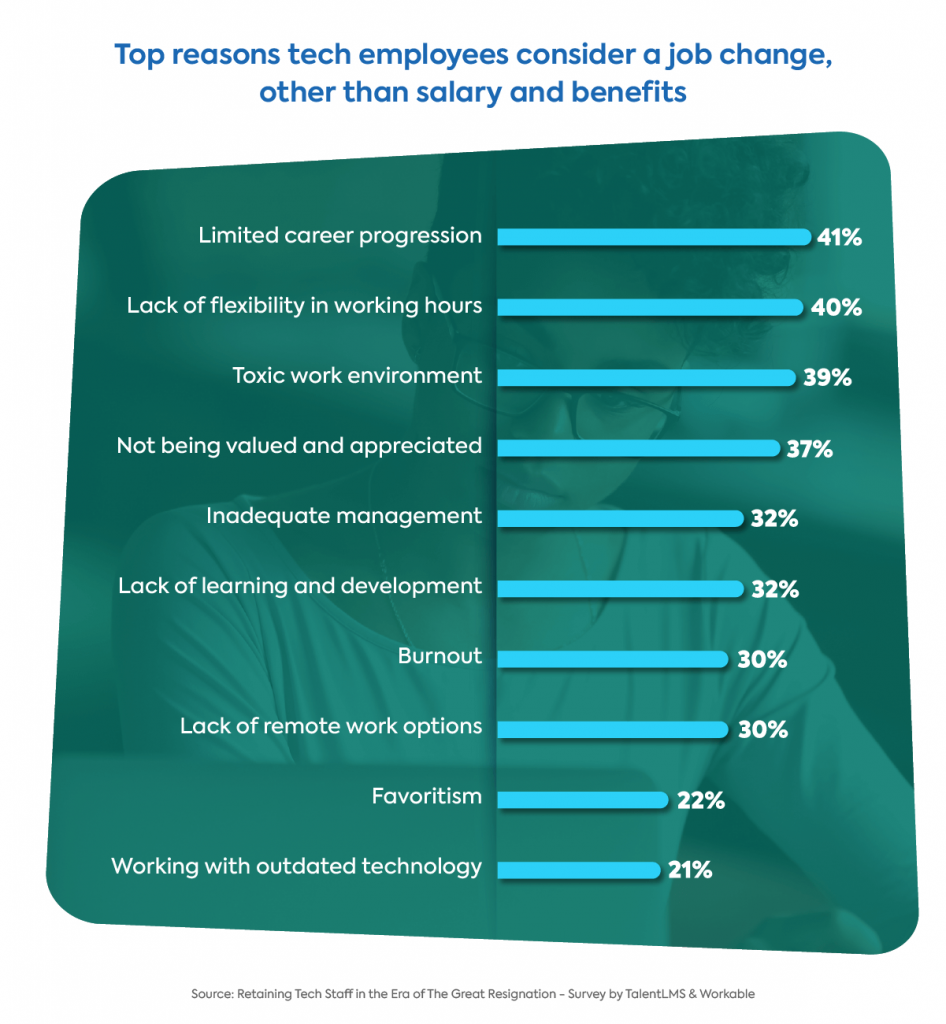
Attracting and retaining tech talent
What matters most when selecting a job?
According to the US Labor Department, The Great Resignation comes hand-in-hand with a Great Rehiring: in July 2021, the number of job openings increased to a series high of 10.9 million. But what are the key criteria tech workers look for when selecting a company to work for?
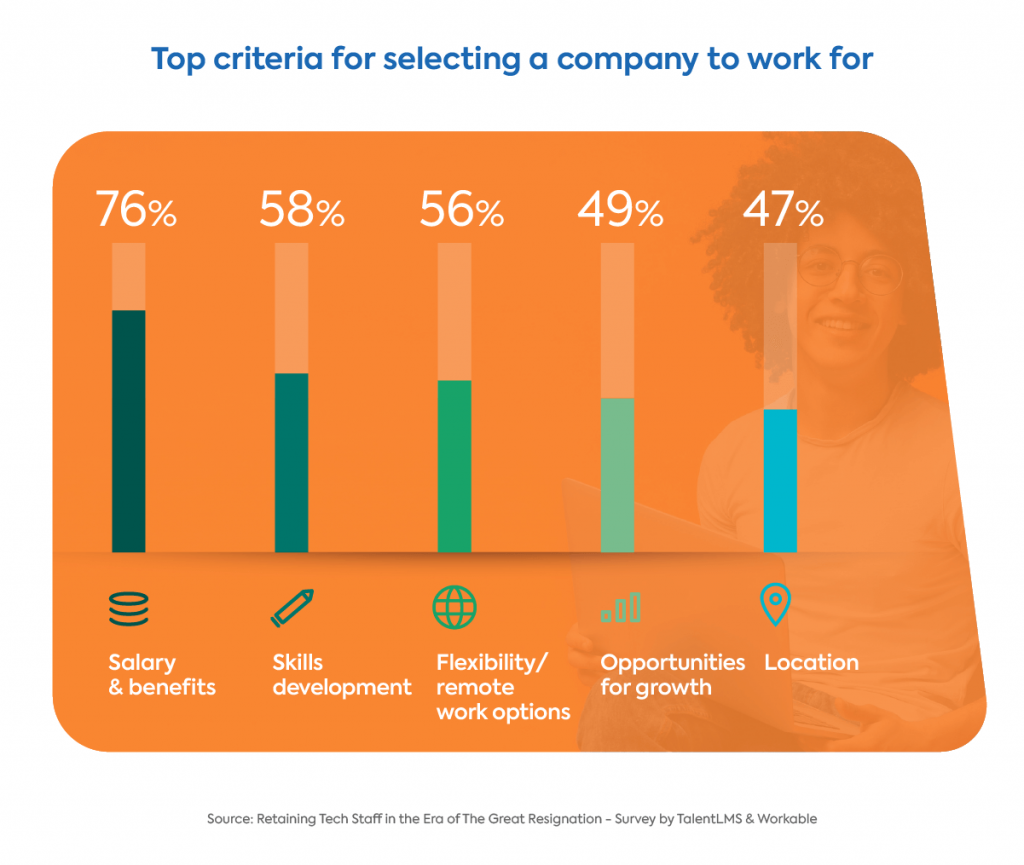
For 3 out of 4 respondents of our survey, the answer is salary and benefits, which is the top criterion for all income and age groups.
Setting salary aside, skills development and flexibility in working hours are the top factors for selecting a company. And almost half of the respondents stated opportunities for growth and location as reasons to accept a job. It’s clear that development and growth play a crucial role for tech employees. Moreover, location still plays an important part for many respondents — something for companies to consider, as many employees are headed back to office environments.
“We’re no longer in a crazy time. We’re in new times, which call for new rules of engagement when attracting talent – especially when recruiters and employers are struggling to fill roles. The onus is now on employers to really step up their talent attraction game – and loosen the requirements for a role. There’s a huge path to get there: find and hire those top prospects, and develop them when they’re with you. There is a lot of nascent talent out there – it’s about finding them and working with them to realize their fullest potential with you. That’s a powerful attractor – and retainer – for your employee base in these new times.”
What motivates tech employees
For almost 2 out of 3 employees, it is more learning and training. Combined with L&D opportunities being one of the top criteria for selecting a job, the message is clear: training can help slow down the wave of resignations.
A TalentLMS survey on 1,000 remote workers from earlier this year showed that learning and development are a driving force both for employee confidence and productivity.
Tech employees seem to feel the same. Being offered more training and learning, as well as being able to work flexible hours, are the two main motivators among tech workers.
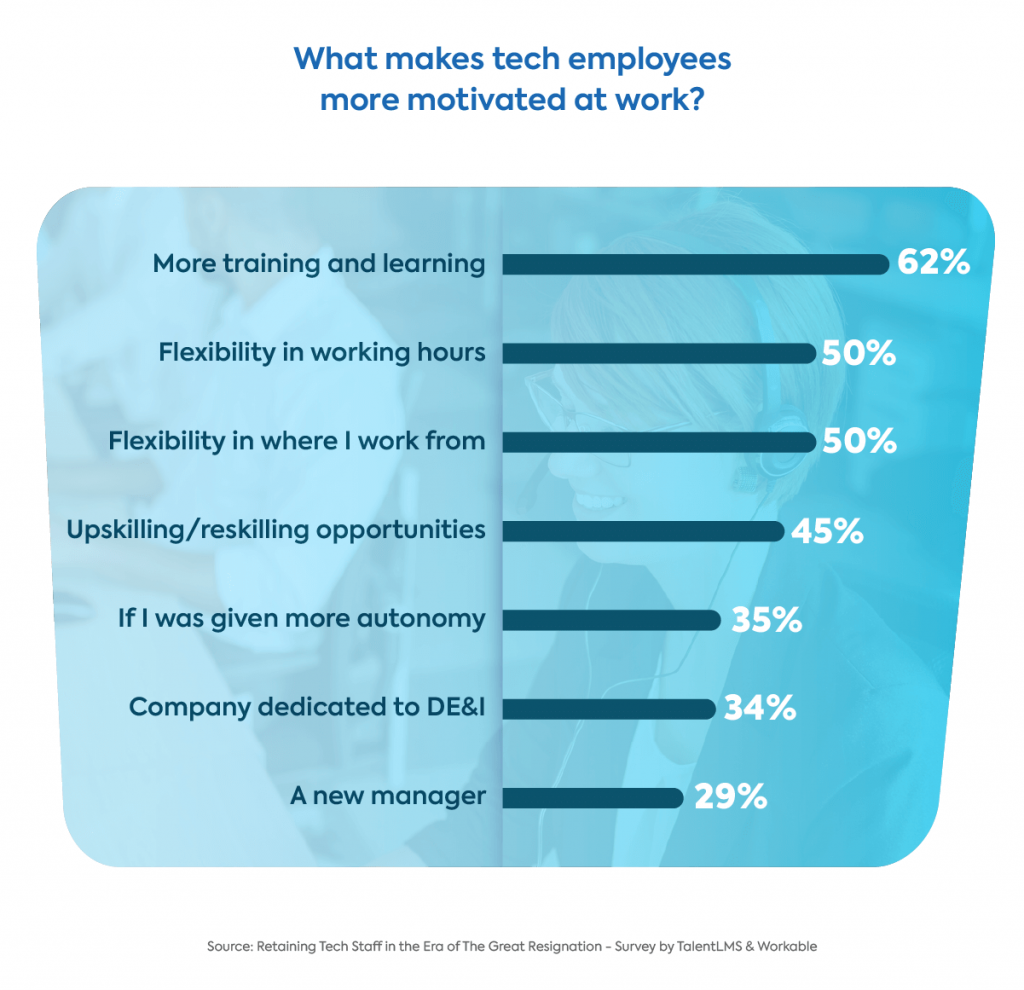
Commenting on the findings of the current survey, Dr. Anthony Klotz also highlighted the importance of learning and development for employee retention:
“While the percentage of individuals thinking about resigning may be high, the good news for organizational leaders is that many of the top reasons that employees provided for wanting to leave are readily addressable. That is, providing workers with more opportunities for development and career advancement, giving them more flexibility in how they structure their workdays, increasing salaries, and providing benefits that employees want are all quickly actionable. There is an opportunity here for companies to talk to their employees about these issues in the wake of the pandemic, and then trial or implement potential solutions.”
On the other hand, the impact of a new manager as a motivator scored the lowest among tech workers, despite managers generally increasing job satisfaction and engagement.
Employees in IT desire more learning opportunities

Another survey showed that 21% of U.S. employees say that learning and development is an area where they’d like to see their current employer improve.
Looking at IT employees specifically, the current findings reveal just how much they care about training. When asked whether they would like to get more learning and development opportunities from their current employer, a sweeping 9 in 10 employees working in tech said yes. But what kind of training do they need?
Future-proof your organization with skills-based training
Unlock your teams’ full potential with TalentLMS.
Sign up in seconds, test the platform forever, upgrade whenever.
The most important skills for tech workers
A combination of learning new skills and developing their existing ones seems to resonate with nearly half of the respondents. This makes sense for tech roles, where cutting-edge new developments are commonplace.
The survey also showed a preference for hard over soft skills. When asked what kind of skills they’d like to learn, tech workers placed technical skills related to their current role or project first (65%), followed by “technical skills related to emerging technologies” (60%). On the other hand, soft skills, such as communication, leadership, project management, and time management, were picked by almost half of the respondents.”

Machine learning and AI are the most in-demand tech skills

When discussing the technologies that would help tech workers stay competitive in the job market, 2 out of 3 respondents chose machine learning and AI as the most in-demand skills for them. This comes as no surprise: according to McKinsey’s Tech Trends Index, applied AI ranks consistently high across industries. Cloud native development, blockchain, and UI design are also in-demand skills for almost half of the respondents.
“The realization that remote working is a viable alternative for IT employees has created many employment options that are no longer geographically constrained. With the need for highly-skilled IT professionals at an all-time high, the survey from TalentLMS and Workable shows that tech workers are increasingly viewing learning and upskilling as a top career priority.”
How tech employees prefer to learn
When it comes to learning formats, almost 3 out of 4 respondents chose video tutorials. After a long period of zero physical events and in-person training (due to COVID-19), slightly more than half of the respondents picked methods such as workshops, seminar,s and conferences as a preferred learning method.
Books still play an important role following at third place (41%), while University programs are the least preferred learning method.

Shedding light on tech employees who want to quit
Examining the impact of the pandemic on tech workers’ reasons for quitting, we asked respondents to choose from a range from “Strongly Agree” to “Strongly Disagree” to the statements below. The results in the graph show the aggregate percentage of the “Strongly Agree” and “Somewhat Agree” answers.
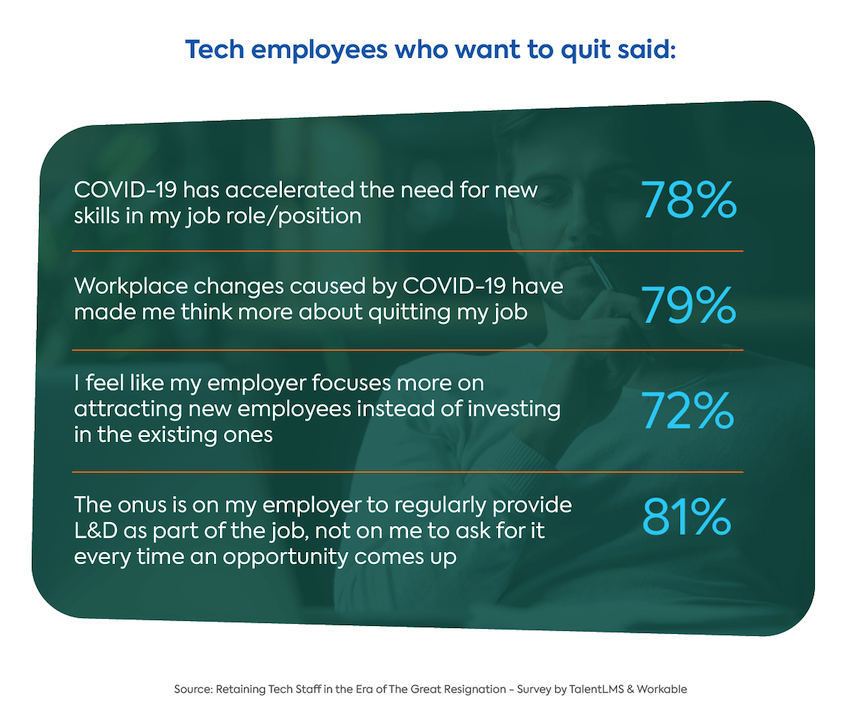
For the majority of respondents, workplace changes caused by COVID-19 have made them think more about quitting their jobs. And it doesn’t help that most companies seem to focus more on hiring than on retention. While 72% of those who want to quit agree that their employers focus more on attracting new employees, the percentage increases to 75% for the total sample of 1,200 respondents.
Post-COVID, the need for new skills has become more important for 3 out of 4 respondents. And it’s important for tech employees to have training as an integral and regular part of their job, provided by their employers: more than 8 out of 10 feel that the effort to catch up on necessary skills shouldn’t fall on their own shoulders.
Before and after the pandemic
It is worth noting that 6 out of 10 respondents have been working with the same company as they were before the pandemic. Among the group that have had a job change since the pandemic, 21% said they quit and moved on, and another 19% had to find a new job after the previous one came to an end.
Finally, when it comes to post-pandemic company policies on remote work, the results were mixed. More than 1 out of 3 employees (39%) said that their company will keep the remote work options introduced due to COVID-19, and 18% said their company already had a remote work policy in place, even prior to the pandemic. However, 27% of the respondents said that their company has backpedaled on remote work options, while 6% said that their company never introduced remote work
Pandemic burnout
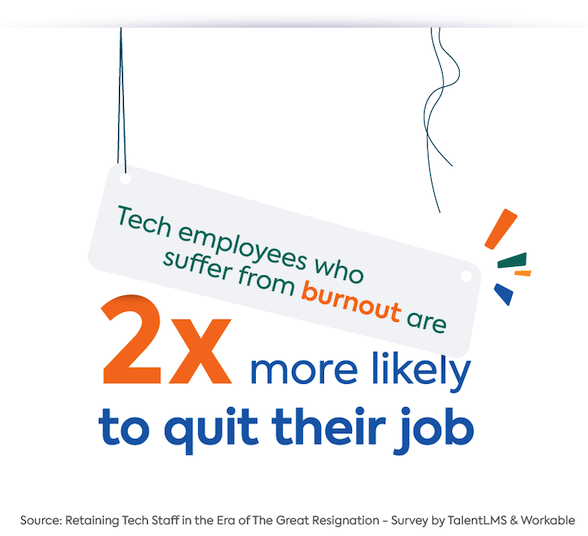
Burnout is a real problem across professions, especially for managers who feel the need to be constantly “on” and struggle with delegating. The rise of remote work seems to have worsened the issue for some: Last year marked a correlation between working from home and worsened mental health or feelings of burnout.
Even though employees are slowly returning to the offices or switching to working in a hybrid environment, the problem of burnout still persists. When asked if they suffer from burnout, 58% of the respondents answered yes.
Among the group of respondents that do suffer from burnout, almost 9 out of 10 (89%) are thinking of quitting their jobs. As for those who indicated they don’t suffer from burnout, the number drops to 48%.
When are tech workers most productive?
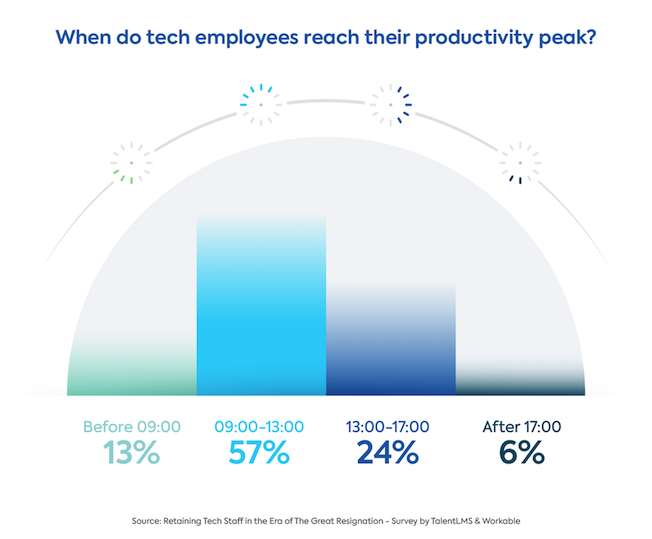
Remote and hybrid work environments have changed the way we work — but have they changed the working hours during which we are most productive?
It’s interesting to see that the traditional “9-5” workday still coincides with tech workers’ most productive hours. More than half of the respondents said they feel more productive between 9 a.m. to 1 p.m., and almost 1 out of 4 said between 1 p.m. to 5 p.m. When filtering for respondents who suffer from burnout, the majority of them (54%) still prefer to work between 9 a.m. and 1 p.m.
Knowing the most productive working hours is important for managers and employers in order to schedule meeting times and other activities to avoid interfering with their employees’ workflow.
Real advice from real employees
With The Great Resignation having a huge impact on tech employees, we wanted to get their own opinions on what companies should do to keep their talent. Respondents gave their advice to companies in an open-ended question at the end of the survey. Three main themes emerged from respondents’ answers:
Nurture your existing employees and show them your appreciation
Three out of 4 respondents feel that their companies are prioritizing new hires instead of focusing on nurturing their existing employees. This strategy needs to change in order for tech workers to feel more motivated to remain at their jobs.
“Focus on employees internally instead of looking for new talent. Help the ones you have develop new skills and enhance their current capabilities.”
“Appreciate your people and reward them with meaningful work and growth opportunities.”
Provide more training and career development opportunities
Continuous employee training is fundamental across industries — let alone within a sector where change happens so rapidly. Tech workers need more opportunities to level up, both in terms of skills and in terms of career progression.
“Always give the opportunity to move up and teach them more valuable skills.”
“Try to make better options for learning new skills and development.”
Offer flexibility and a better work-life balance
Flexibility in location, schedule, and management style. With 1 out of 4 respondents reporting that their company has already backpedaled on their remote work options post-COVID, it’s important to remember that remote and hybrid environments are not a passing fad. They cover real needs; they’re here to stay.
“Ensuring flexible working hours and work from home policy.”
“There must be a balance of work and personal life for your tech talent. Payment and benefits must be good, above average.”
“Throw out your 1950s playbook, and remove the middle managers whose job is only justified if they can physically look over [our] shoulders. And let us go remote.”
About the survey
The survey was conducted online between September 10-12, 2021, on a random sample of 1,200 U.S. employees who work in tech/IT/software departments across industries. Fifty-six percent of respondents were male, and 44% were female.
Research team
Eri Panselina (TalentLMS), Ana Casic (TalentLMS),and Keith Mackenzie (Workable).
Jump right in with
ready-made courses
TalentLibrary™: Ready-made training for real-world skills
Bring out the best in your teams.
Get started with the most versatile and affordable employee training platform, no credit card needed.


